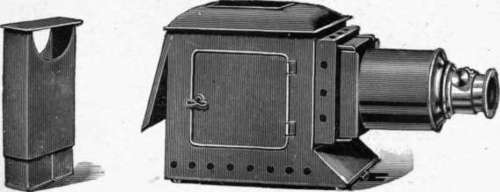Chapter XXIV. The Magic Lantern And Its Use
Description
This section is from the book "The Sinclair Handbook Of Photography", by James A. Sinclair. Also available from Amazon: The Sinclair handbook of photography.
Chapter XXIV. The Magic Lantern And Its Use
I purposely use the term " magic lantern," although this old title has how fallen into desuetude. Educationalists know the great value of early impressions and I doubt if any entertainment so much impressed me, when a small boy, as a magic lantern show. Even the small oil lantern which we had at home, probably costing not more than 10/6 with slides complete, despite the smoke and smell, was always a source of great delight to the family, and to this day I vividly remember the somewhat fantastic hand-painted slides ; but, an event of quite considerable importance was my visit to a really good Christmas exhibition for children, and the moving picture of a man swallowing macaroni had, for me, all the elements of reality, and I would even now be prepared to affirm that I saw a real man swallowing real macaroni, were I not assured that it was only a magic lantern entertainment. Even to-day there is quite an element of " magic " in transporting some scene from France or Italy and seeing it on the screen, even when the work has been entirely my own, and it is on account of these personal early impressions and delights that I would suggest the value of the lantern particularly to those interested in children. The importance of the eye as an educational factor is not sufficiently recognised, and probably the home-made lantern slide of familiar scenes is a finer stimulus to the imagination than the most perfect of modern moving picture shows.

An inexpensive Lantern with 4-wick Lamp and 4-in. Condenser.
If we consider the subject favourably the first thing affecting most of us is the cost, and in this, as in all other recreations, much depends on the depth of our pockets. It is a great mistake to think that a lantern is necessarily very expensive, for without thinking of the toy sets, which are hardly suitable if we propose to make our own slides, a good lantern, suitable for home use, which takes the regular 3 1/4 X 3 1/4 inch lantern slides, may be had for £1 5s. Of course, this is what may be considered as the minimum price, and we will now proceed to describe the construction of the instrument and see in what way the more expensive forms are superior to the quite good and simple one which we have mentioned.
WHAT DOES IT COST ?
The general form of the lantern is well known and consists of : - A body to hold the light. A condensing lens to collect the rays from the light and transmit them through the slide to the objective. A carrier to hold the lantern slide in a vertical position near the condenser. An objective or lens to project the picture in sharp focus on to the screen. The optical arrangement is shown in the following diagram : THE CONSTRUCTION OF THE LANTERN.
All of the foregoing parts are necessary, no matter how cheap the lantern may be, and it is only in the perfection of each part and the method of their combination that differences in cost may arise. Let us now discuss the details more fully.

THE LANTERN BODY.
The lantern body in the cheaper lanterns is of japanned tin, but in those of better quality it is made of Russian iron or aluminium, and in the best forms the metal body is covered with an outer case of polished mahogany. With the last mentioned the advantages are those of appearance and coolness. Between the mahogany and the metal body is a space which carries off all heat to the top of the lantern, and this greatly conduces to the comfort of the operator during a long show. For general use, at a moderate price, there is nothing better than a Russian iron body, and it is desirable that this should be large and well ventilated, with a properly fitting side door to allow of the examination of the light from time to time. The front of the lantern body is usually fitted with a brass stage to support the objective, and this should be very rigid, so that the lens is kept parallel with the surface of the lantern slide.
When it is likely that the lantern will be required in a large room or hall, the front, which holds the objective, must of necessity extend considerably, and where the front is of brass such extension is usually made possible by means of telescopic lengthening tubes. In the more expensive lanterns these tubes are fitted with racks and focussing screws. The reason for this extension will be mentioned later, when we speak of the lens.
Continue to:


